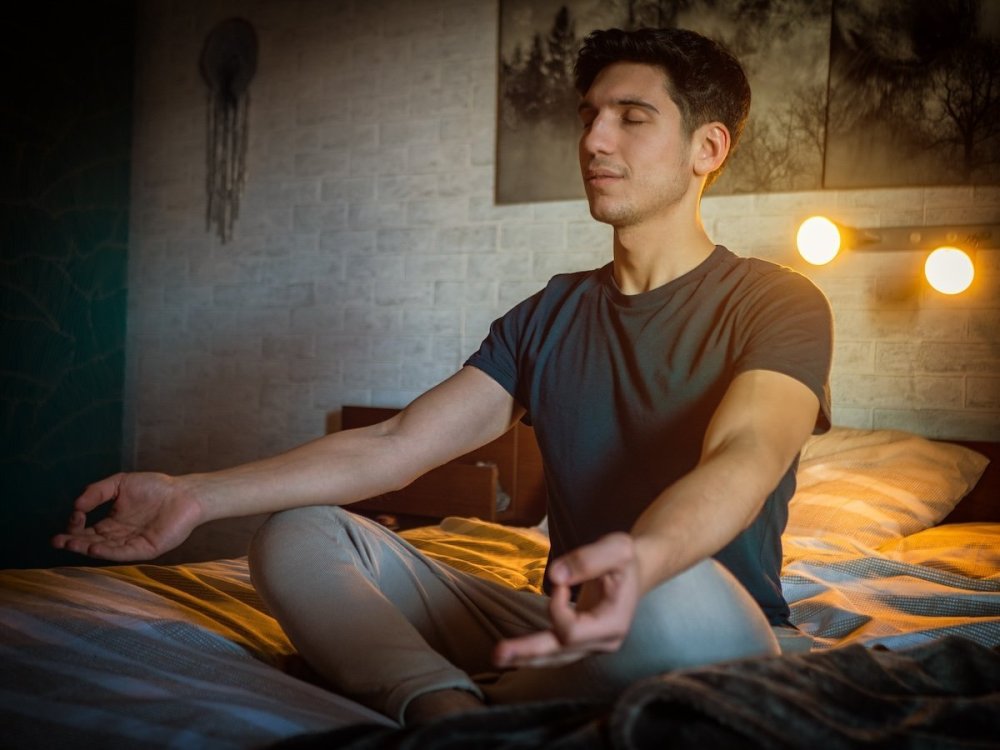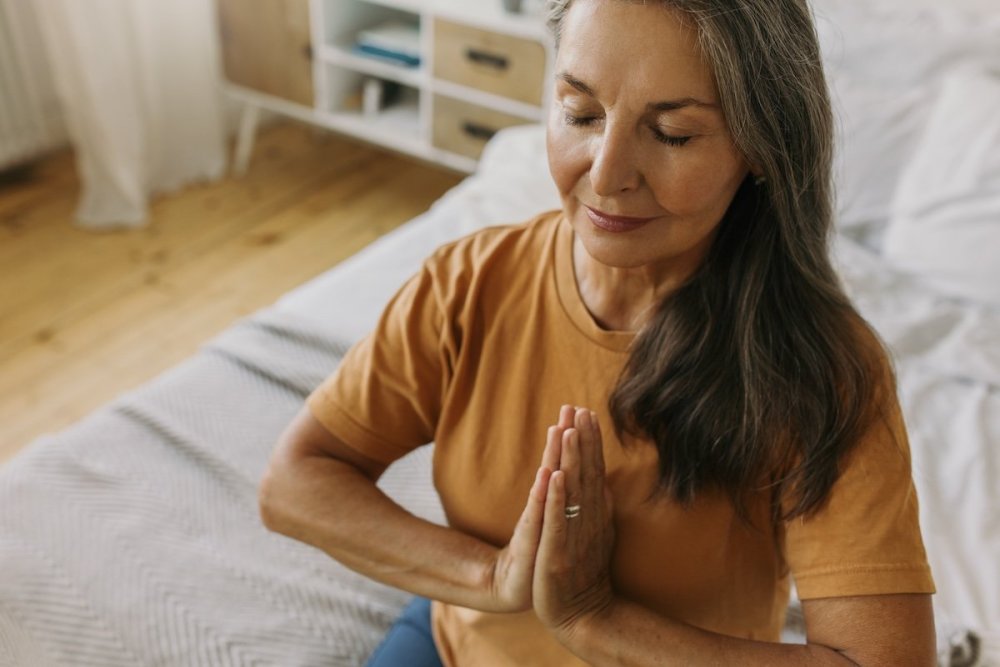Meditation before bed helps us to wind down our bodies and mind after a long day, encouraging restful and peaceful sleep. This 'how to meditate in bed for beginners' guide from Ann Vrlak will teach you all you need to know, including a simple 3-step practice.
If you've ever tried meditation, you may know that one of the big challenges for many people is not falling asleep. So, it’s understandable that you might see falling asleep during a meditation practice as proof that you are “doing it wrong.”
However, there are times when falling asleep during or right after meditation is actually proof you’re “doing it right!”
Welcome to our short guide on how to meditate in bed for beginners. Our focus is how to use meditation before sleep, but please use this guide whenever you want are seeking a period of calm or rejuvenation in your day.

Meditation before bed helps you wind down for sleep
While it’s true that most meditation practices are centered around paying attention and staying alert, meditation is also uniquely suited to help you transition from a busy day, to a relaxed state, and then into a restful sleep. In fact, lying down while meditating or the traditional practice of yoga nidra have benefits that sitting meditations don’t.
As you're probably aware, insomnia and poor sleep are worldwide problems. Tools that help you to fall asleep easily and have quality sleep are invaluable for your health and well-being.
The benefits of meditating in bed
Let’s look first at some of the many mental, physical and emotional benefits to learning how to meditate in bed.
From Activity to Sleep
The overall benefit is enabling the transition we have mentioned from your daily level of activity, into a state that is conducive to sleep. Because you can’t make yourself sleep! You need to create the conditions that activate your body’s natural sleep mechanisms. You may already have noticed that winding down at the end of a stressful day is not always easy.
“Our focus here is on how to use meditation before sleep, but please use this this guide on how to meditate in bed for beginners whenever you're seeking a period of calm or rejuvenation during your day.”
Meditation in bed is a perfect practice for this transition. You are lying down, able to relax physically and mentally. You turn your attention inward away from external responsibilities to your body and breath–something that can be impossible to do in the middle of a busy day.
A Signal to Relax
When you meditate in bed, it’s a clear signal to your body that your intention is to prepare for sleep. Studies have shown that a familiar sleep routine is a key support for your body to fall asleep easily. Your body “remembers” this is the time to let go and sets your sleep mechanisms in motion. When you meditate in bed with some regularity, this will create a powerful sleep signal for both your body and mind.
Not All Sleep is Created Equal
Have you ever woken up from a night’s sleep feeling more tired than when you lay down? There can be a lot of reasons for a poor sleep, but the takeaway is that, just because you had 8 hours of sleep, it doesn’t mean it was quality, restorative sleep.
MORE LIKE THIS:
- Deep Sleep Meditation: the Benefits You Can Bring to Bed
- 14 Sleep Hacks to Get a Good Night's Rest
- Cat Naps: 5 Benefits of Taking a Siesta
One of the most common obstacles to quality sleep is a busy, worried mind. If you meditate in bed, before trying to fall asleep, you are training your mind to move into a quieter state first. This can make the quality of your sleep deeper and more restful.
Making Bedtime a Time for Reflection
Meditation in bed is also a way to end your day with some quiet reflection, before going to sleep. A few minutes of kind, compassionate reflection on your day can be a wonderful way to let go of any worry that may be lingering in your mind. You can use meditation to consciously relax your body and mind, and do your best to let worry go – just for now.

Reflect kindly and compassionately on your day before resting
You’re in a Receptive State
When you’re winding down after a tiring day, your body and mind are ready to relax! You’re in a receptive state for slowing down your thinking, letting go of emotions and relaxing your body.
How to Meditate in Bed for Beginners
Here is our step-by-step guide for how to meditate in bed. We’re going to describe two classic meditation practices designed to connect you with your body and help you relax, bit by bit: a body scan and a progressive relaxation practice. Simply follow our three-step guide:
1. Begin
Take a few minutes to get as comfortable and cosy as you can. Use blankets and pillows to warm and support your body in whatever ways feel best to you. When you're comfortable, let your eyes gently close. Allow your body to rest completely on the bed and begin to pay attention to the movements of your breath.
2. Do a Body Scan
Beginning at the top of your head, pay attention to the sensations in your body. What do you feel in your scalp? Is it warm or cold, tight or relaxed? Whatever you notice is good. When you feel you have made connection with the sensations in your scalp, move into your forehead and cheeks. What do you notice here?
“Meditation in bed is a way to end your day with some kind, compassionate reflection – a wonderful way to let go of any worry before going to sleep.”
Let your attention move gradually down through all parts of your body from your head to your toes – from your shoulders and arms, your torso, your legs and feet. Notice, quietly to yourself, whatever you sense in each part. Are there aches or pains? Can you feel your pulse in any of these body parts? Take notice and be in the moment with these bodily sensations you may not recognise during the day.
When you’ve reached your toes, rest for a moment. Feel the weight of your body sinking into the bed. Focus on the contact of your body on the mattress. Enjoy the quiet and stillness. Notice your body as a whole field of sensation and energy, lying here, resting.
3. Do a Progressive Relaxation Practice
This practice is a similar movement of your attention through your body. The difference is you consciously tense and relax each part of your body. Many people find this practice is easier to do with larger parts of the body, rather than very specific parts. For example, trying tensing your whole arm vs just your forearm.

Mediating in bed needs no experience: beginner's welcome!
Starting with your face, tense up your forehead, eyes and cheeks. Tighten all the muscles as best you can. Then, let the whole area relax, feeling the muscles all letting go. Imagine your facial skin drooping downwards to the mattress. Notice the difference between the tension and the release. Continue this progressive relaxation practice all the way down your body to your feet and toes.
Notice how your body feels when you complete the practice. Is it lighter or heavier? And how does your mind feel? Are you aware of any changes in your body or mind from before you began these two practices? It’s really important to notice the effects of your practice – it can boost your motivation to make it a regular habit.
When you are ready, gently congratulate yourself for trying these practices. And let yourself relax even more, until sleep comes.
Takeaway: how to meditate in bed
We hope you’ve enjoyed this guide on how to meditate in bed for beginners and feel excited to give it a try! In the multitasking, speed-oriented world we live in, it is not so surprising that slowing down into sleep is not always as easy as it sounds.
Meditation in bed is a simple, safe, healthy way for you to help your body make a restful descent into sleep. You can create a space between your day and sleep where you turn your attention inward and reflect gently on – and let go of – your day.
A healthy sleep routine is one of the best ways to reset your body’s natural sleep clock, and meditation can be a powerful, safe part of that routine. Sweet dreams! •
Images: shutterstock/Dzmitryieu Dzmitry, shutterstock/ArtOfPhotos, shutterstock/shurkin_son
happiness.com | The fine art of being: learn, practise, share
Are you a happiness.com member yet? Sign up for free now to enjoy:
■ our happiness magazine with practical life tips
■ share and support in our happiness forum
Written by Ann Vrlak
 Ann Vrlak is Founder of OneSelf Meditation and a meditation practitioner for over 25 years. She’s a Certified Meditation Teacher for adults and for children (the best job ever!). She loves to share how the perspective and practice of meditation can support people with their everyday stresses and on their journey of self-discovery.
Ann Vrlak is Founder of OneSelf Meditation and a meditation practitioner for over 25 years. She’s a Certified Meditation Teacher for adults and for children (the best job ever!). She loves to share how the perspective and practice of meditation can support people with their everyday stresses and on their journey of self-discovery.



Join the conversation
You are posting as a guest. If you have an account, sign in now to post with your account.
There are no comments to display.